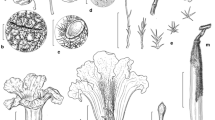Abstract
The Qinghai–Tibetan Plateau is biologically diverse, with 9556 species of vascular plants in the 2,500,000 km2 plateau area. We focused on seed plants from the Qinghai–Tibetan Plateau. A total of 9321 species in the Qinghai–Tibetan Plateau were recorded. Sixty-one of these genera are Chinese endemics. Our results suggested that the flora of the Qinghai–Tibetan Plateau was characterized by relatively few polyploids, and aneuploidy was also considered as relatively rare. We inferred that aneuploidy may be affected by environmental factors and the addition or loss of centromeres. Furthermore, the highest frequency of polyploids was found among perennial herbs. Annuals had low polyploidy, and perennials had high polyploidy. Species richness was correlated with the incidence of polyploids, environmental conditions, and reproductive isolation.




Similar content being viewed by others
References
Ahuja MR (2005) Polyploidy in gymnosperms: revisited. Silvae Genet 54:59–69
Bennett MD (2004) Perspectives on polyploidy in plants-ancient and neo. Biol J Linn Soc 82:411–423. doi:10.1111/j.1095-8312.2004.00328.x
Boufford DE, van-Dyck PP (1999) South-Central China. In: Mittermeier RA, Myers N, Mittermeier CG (eds) Hotspots: earth’s biologically richest and most endangered terrestrial ecoregions. Cemex, Mexico, pp 338–351
Bowers JE, Chapman BA, Rong JK, Paterson AH (2003) Unravelling angiosperm genome evolution by phylogenetic analysis of chromosomal duplication events. Nature 422:433–438. doi:10.1038/nature01521
Brown WV (1972) Textbook of cytogenetics. Mosby, Saint Louis
Darlington CD (1937) Recent advances in cytology. P. Blakiston’s Son & Co, Philadelphia
Ehrendorfer F (1980) Polyploidy and distribution. In: Lewis WH (ed) Polyploidy: Biological Relevance. Plenum, New York, pp 45–60
Goldblatt P (1980) Polyploidy in angiosperms: monocotyledons. In: Lewis WH (ed) Polyploidy: biological relevance. Plenum Press, New York, pp 219–239
Goldblatt P, Johnson DE (1979) Index to Plant Chromosome Numbers (IPCN). Missouri Botanical Garden, St. Louis
Grant V (1963) The origin of adaptations. Columbia University Press, New York
Grant V (1981) Plant speciation. Columbia University Press, New York
Griffiths AJF, Miller JH, Suzuki DT, Lewontin RC, Gelbart WM (2000) Transcription: an overview of gene regulation in eukaryotes, an introduction to genetic analysis, 7th edn. W. H. Freeman and Company, New York
Gustafsson A (1948) Polyploidy, lifeform and vegetative reproduction. Hereditas 34:1–22. doi:10.1111/j.1601-5223.1948.tb02824.x
Hewitt G (2000) The genetic legacy of the quaternary ice ages. Nature 405:907–913. doi:10.1038/35016000
Khoshoo TN (1959) Polyploidy in Gymnosperms. Evolution 13:24–39. doi:10.2307/2405943
Levin DA (2004) The ecological transition in speciation. New Phytol 161:91–96. doi:10.1046/j.1469-8137.2003.00921.x
Lewis WH (1980) Polyploidy in angiosperms: dicotyledons. In: Lewis WH (ed) Polyploidy: biological relevance. Plenum Press, New York, pp 241–268
Li XW, Li J (1993) A preliminary floristics study on the seed plants from the region of Hengduan Mountain. Acta Bot Yunnan 15:217–231
Liu JQ (2004) Uniformity of karyotypes in Ligularia (Asteraceae: Senecioneae), a highly diversified genus of the eastern Qinghai–Tibet Plateau highland sand adjacent areas. Bot J Linn Soc 144:329–342. doi:10.1111/j.1095-8339.2003.00225.x
Liu JQ, Liu SW, Ho TN, Lu A (2001) Karyological studies on the Sino-Himalayan genus, Cremanthodiurn (Asteraceae: senecioneae). Bot J Linn Soc 135:107–112. doi:10.1111/j.1095-8339.2001.tb01085.x
Lutz AM (1907) A preliminary note on the chromosomes of Oenothera Lamarckiana and one of its mutants, O. gigas. Science 26:151–152. doi:10.1126/science.26.657.151
Masterson J (1994) Stomatal size in fossil plants: evidence for polyploidy in majority of angiosperms. Science 264:421–423
Morton JK (1993) Chromosome numbers and polyploidy in the flora of Cameroons Mountain. Opera Bot 121:159–172
Muntzing A (1933) Hybrid incompatibility and the origin of polyploidy. Hereditas 18:33–35. doi:10.1111/j.1601-5223.1933.tb02596.x
Muntzing A (1936) The evolutionary significance of autopolyploidy. Hereditas 21:263–378. doi:10.1111/j.1601-5223.1936.tb03204.x
Nie ZL, Gu ZJ, Sun H (2002) Cytological study of genus Tibetia (Fabaceae) in the Hengduan Mountains Region, China. J Pl Res 115:17–22. doi:10.1007/s102650200003
Nie ZL, Wen J, Gu ZJ, Boufford DE, Sun H (2005) Polyploidy in the flora of the Hengduan Mountains hotspot, Southwestern China. Ann Missouri Bot Gard 92:275–306
Otto SP, Whitton J (2000) Polyploid incidence and evolution. Annual Rev Genet 34:401–437. doi:10.1146/annurev.genet.34.1.401
Packer JG (1969) Polyploidy in the Canadian Arctic Archipelago. Arctic Alpine Res 1:15–28. doi:10.2307/1550357
Sanderson SC, Strother JL (1973) The origin of aneuploidy in Hymenoxys odorata. Nature New Biol 242:220–221. doi:10.1038/newbio242220a0
Sax HJ (1932) Chromosome pairing in Larix species. J Arnold Arbor 13:368–373
Schulz-Schaeffer J (1980) Aneuploidy, cytogenetics. Springer, New York
Stebbins GL (1951) Variation and evolution in plants. Columbia University Press, New York
Stebbins GL (1985) Polyploidy, hybridization, and the invasion of new habitats. Annu Missouri Bot Gard 72:824–832. doi:10.2307/2399224
Wang HS (1989) A study on the origin of spermatophytic genera endemic to China. Acta Bot Yunnan 11:1–16
Wang L, Gu ZJ, Gong X, Xiao TJ (1993) A cytological study on fifteen species in six genera of Liliaceae from Yunnan. Acta Phytotaxon Sin 31:549–559
Wang L, Gu ZJ, Gong X, Sun H (1994) Preliminary karyomorphological study on the plants in genera Oxytropis and Astragalus from Qinghai–Xizang Plateau. Acta Bot Yunnan 16:53–59
Wu ZY (1991) The areal-types of Chinese genera of seed plants. Acta Bot Yunnan 13(Suppl.IV):1–139
Wu YH (2008) The vascular plants and their ecogeographical distribution of the Qinghai–Tibetan Plateau. Science Press, Beijing
Wu ZY, Sun H, Zhou ZK, Peng H, Li DZ (2007) Origin and differentiation of endemism in the Flora of China. Frontiers Biol China 2:125–143. doi:10.1007/s11515-007-0020-8
Yuan Q, Yang QE (2008) Low incidence of polyploidys and high uniformity of karyotypes displayed by Delphinium (Ranunculaceae) in the Hengduan Mountains region of southwest China. Bot J Linn Soc 158:172–188. doi:10.1111/j.1095-8339.2008.00849.x
Zheng D (1996) The system of physic-geographical regions of the Qinghai–Xizang (Tibet) Plateau. Sci China (ser D) 39:410–417
Acknowledgements
This work was financially supported by Yunnan Postdoctoral Grants to S. Basak, Major State Basic Research Development Program (2010CB951704), National Natural Science Foundation of China (NSFC) (41271058) to Y. P. Yang, and the General Project of Natural Science Research in Anhui Province (AQKJ2015B018).
Author information
Authors and Affiliations
Corresponding author
Ethics declarations
Conflict of interest
The authors declare that they have no conflict of interest.
Additional information
Handling editor: Karol Marhold.
Rights and permissions
About this article
Cite this article
Wang, GY., Basak, S., Grumbine, R.E. et al. Polyploidy and aneuploidy of seed plants from the Qinghai–Tibetan Plateau and their biological implications. Plant Syst Evol 303, 565–571 (2017). https://doi.org/10.1007/s00606-017-1396-9
Received:
Accepted:
Published:
Issue Date:
DOI: https://doi.org/10.1007/s00606-017-1396-9




